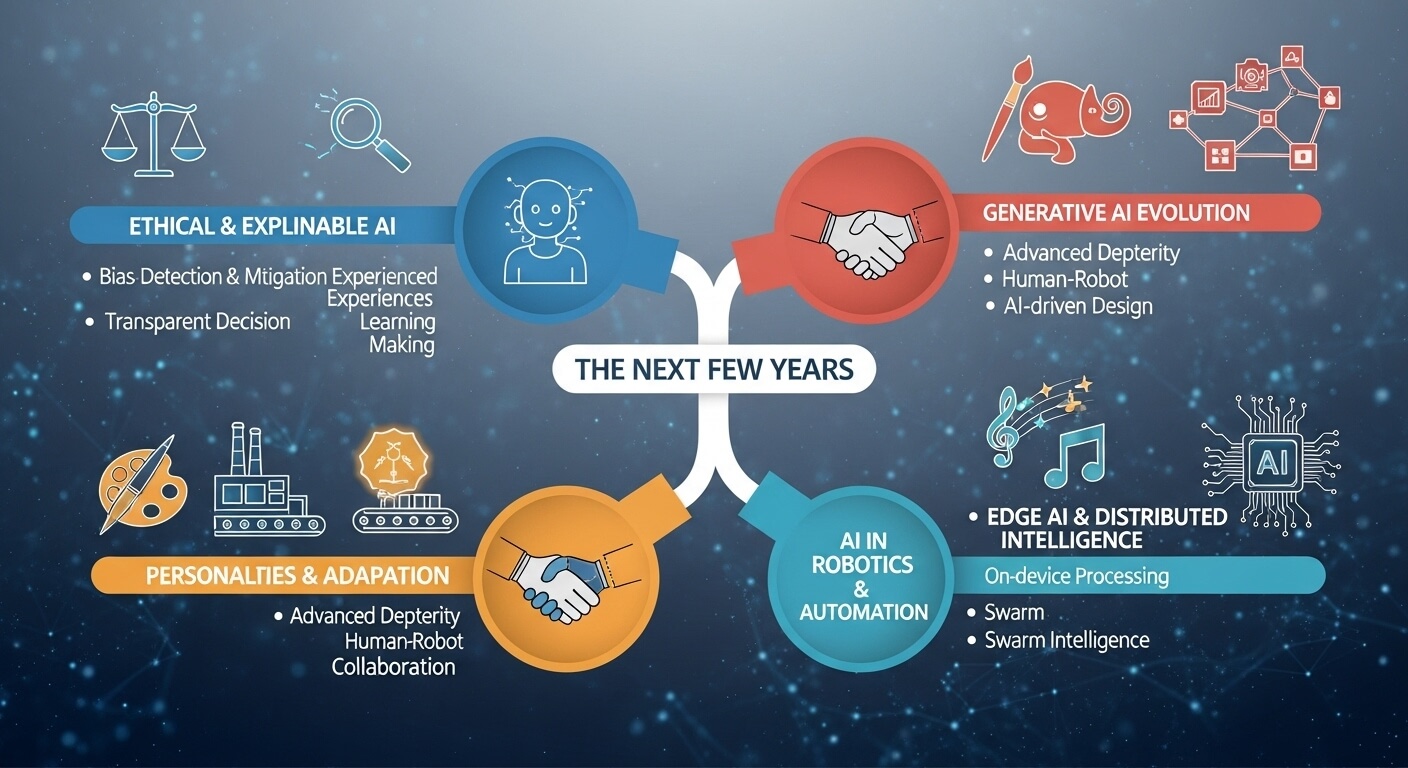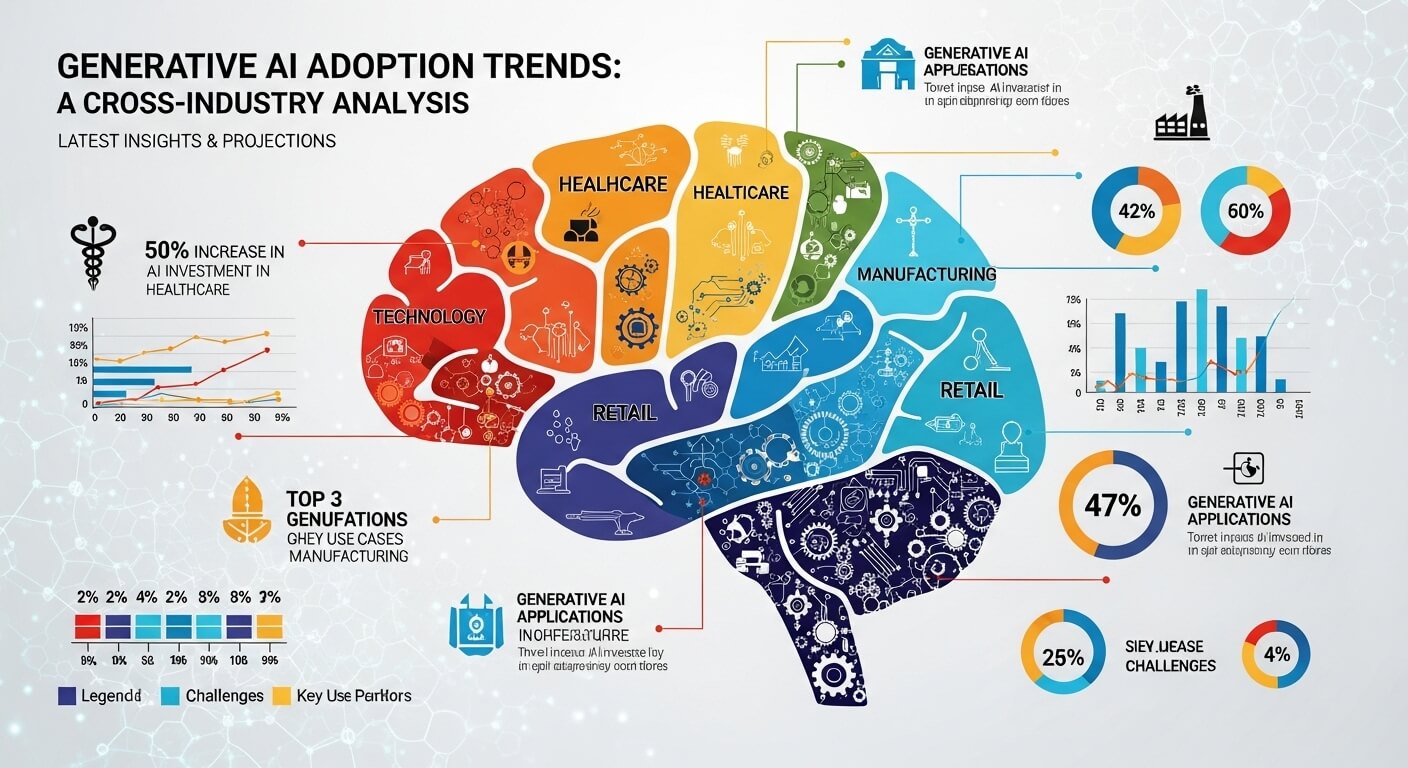Artificial Intelligence (AI) is evolving at an unprecedented pace, reshaping industries, economies, and daily life. As we look toward the next few years, understanding what future trends in AI should I watch for is critical for businesses, professionals, and enthusiasts aiming to stay ahead in this dynamic field. From generative AI advancements to ethical frameworks and AI-driven automation, the coming years promise transformative developments. This comprehensive 3,000-word guide explores the top AI trends to watch from 2025 to 2028, supported by authoritative insights, industry reports, and real-world examples, ensuring you’re equipped to navigate the future of AI.
Why Tracking AI Trends Matters
AI is no longer a futuristic concept; it’s a cornerstone of innovation across sectors like healthcare, finance, retail, and manufacturing. According to McKinsey, AI could contribute $15.7 trillion to the global economy by 2030, with generative AI alone driving $6.1–7.9 trillion in value. Staying informed about emerging AI trends enables:
- Strategic adoption of high-impact technologies.
- Competitive differentiation in crowded markets.
- Mitigation of risks like ethical concerns or regulatory compliance.
- Workforce upskilling to align with AI-driven roles.
- Identification of investment opportunities in AI startups and tools.
This guide highlights key trends, credible sources, and actionable insights to help you anticipate and leverage AI’s future.
Top AI Trends to Watch (2025–2028)
The following trends, drawn from industry reports, expert analyses, and real-time data, represent the most impactful AI developments to monitor over the next few years.
1. Generative AI Evolution and Multimodal Models
Generative AI, powered by models like Large Language Models (LLMs), Generative Adversarial Networks (GANs), and diffusion models, is expanding beyond text and images to multimodal capabilities, integrating text, visuals, audio, and video.
- What to Expect:
- Multimodal AI systems (e.g., GPT-5, DALL-E 4) will generate cohesive outputs across formats, enabling applications like real-time video editing or interactive virtual assistants.
- Hyper-personalization in marketing and customer service, with AI tailoring content to individual preferences.
- Growth in creative industries, with AI generating music, films, and 3D designs.
- According to StartUs Insights, the generative AI market is projected to reach $1 trillion by 2034, with a 44.2% CAGR.
- Industries Impacted: Media, retail, healthcare, gaming.
- Sources:
- Forbes: “The Future of Generative AI: What to Expect in 2025” predicts multimodal AI dominance.
- StartUs Insights: Tracks 16,520 generative AI companies, highlighting trends like conversational AI.
- Gartner: Hype Cycle for AI 2025 notes multimodal models entering the “Slope of Enlightenment.”
- Example: Tools like MidJourney and Runway ML are advancing AI-generated video production.
2. AI Agents and Autonomous Systems
AI agents—autonomous systems that perform tasks with minimal human intervention—are gaining traction, driven by advancements in agentic AI and reinforcement learning.
- What to Expect:
- AI agents will handle complex workflows, such as supply chain optimization or customer service automation.
- Integration with IoT for real-time decision-making in smart cities and manufacturing.
- Gartner predicts that by 2028, 33% of enterprise software will embed AI agents.
- Ethical and governance challenges will arise as agents operate independently.
- Industries Impacted: Manufacturing, logistics, customer service, finance.
- Sources:
- Publicis Sapient: “Guide to Next 2025” highlights AI agents as a top enterprise trend.
- Gartner: Forecasts AI agents transforming business functions by 2028.
- X Posts: Industry experts discuss agentic AI’s role in automation (#AI2025).
- Example: xAI’s Grok is evolving into an agentic system for task automation.
3. AI-Ready Data and Synthetic Data
High-quality, AI-ready data is critical for training robust models, but data scarcity and privacy concerns are driving the use of synthetic data generated by AI.
- What to Expect:
- Synthetic data will support training in data-scarce industries like healthcare and finance.
- 57% of organizations lack AI-ready data, per Gartner, fueling synthetic data adoption.
- Privacy-preserving techniques like federated learning will complement synthetic data.
- Market growth from $418 million in 2024 to $2.1 billion by 2030 (Statista).
- Industries Impacted: Healthcare, finance, automotive, research.
- Sources:
- Gartner: Hype Cycle for AI 2025 emphasizes AI-ready data challenges.
- Statista: Projects synthetic data market growth.
- MIT Technology Review: Discusses synthetic data in medical research.
- Example: GenHealth.ai uses synthetic data for patient outcome predictions.
4. Ethical AI and Governance Frameworks
As AI adoption grows, ethical concerns—bias, transparency, and accountability—are prompting stricter governance frameworks.
- What to Expect:
- Global regulations like the EU AI Act will enforce ethical AI standards by 2026.
- Explainable AI (XAI) will gain prominence to ensure model transparency.
- 45% of organizations cite governance as a top challenge, per McKinsey.
- Public demand for bias mitigation and data privacy will shape AI development.
- Industries Impacted: All sectors, especially finance, healthcare, and government.
- Sources:
- McKinsey: Global Survey on AI 2025 highlights governance challenges.
- Forbes: Discusses regulatory impacts on AI adoption.
- Stanford AI Index: Tracks global AI regulation trends.
- Example: The EU AI Act classifies high-risk AI systems, requiring compliance by 2026.
5. AI-Driven Workforce Transformation
AI is reshaping jobs, with automation replacing repetitive tasks and creating demand for new skills.
- What to Expect:
- 80% of engineers will require AI upskilling by 2027, per Publicis Sapient.
- New roles like AI ethics officers and prompt engineers will emerge.
- Generative AI will shift entry-level roles to reviewing AI outputs, per HBR.
- Workforce augmentation will dominate, with AI enhancing human productivity.
- Industries Impacted: Technology, education, customer service, creative industries.
- Sources:
- HBR: “Most-Read Gen AI Articles of 2025” discusses workforce shifts.
- Publicis Sapient: Predicts upskilling needs for engineers.
- World Economic Forum: Forecasts 97 million new AI-driven jobs by 2030.
- Example: Salesforce offers AI training programs to address skill gaps.
6. Edge AI and Decentralized Computing
Edge AI, where AI processing occurs on devices rather than cloud servers, is growing due to privacy, latency, and cost benefits.
- What to Expect:
- Edge AI will power autonomous vehicles, smart devices, and IoT systems.
- Market growth from $9 billion in 2024 to $36 billion by 2030, per Statista.
- Integration with 5G for real-time applications in healthcare and manufacturing.
- Privacy-focused edge AI will address data security concerns.
- Industries Impacted: Automotive, healthcare, manufacturing, retail.
- Sources:
- Statista: Projects edge AI market growth.
- Forbes: Discusses edge AI in autonomous systems.
- Gartner: Hype Cycle for AI 2025 highlights edge AI adoption.
- Example: NVIDIA’s Jetson platform supports edge AI for IoT devices.
7. AI in Sustainability and Climate Tech
AI is increasingly applied to environmental challenges, optimizing energy use, predicting climate patterns, and supporting green initiatives.
- What to Expect:
- AI will optimize renewable energy grids and predict climate risks.
- Carbon footprint tracking using AI will become standard in manufacturing.
- McKinsey estimates AI could reduce global emissions by 10% by 2030.
- Startups like ClimateAI are leveraging AI for climate resilience.
- Industries Impacted: Energy, agriculture, manufacturing, government.
- Sources:
- McKinsey: Reports on AI’s role in sustainability.
- StartUs Insights: Tracks climate tech startups using AI.
- MIT Technology Review: Discusses AI in climate modeling.
- Example: ClimateAI uses generative AI for weather forecasting.
8. Conversational AI and Hyper-Personalization
Conversational AI, powered by advanced LLMs, is enhancing customer interactions and personalization across industries.
- What to Expect:
- Chatbots like WeBoard’s Kaila will automate 70% of customer service interactions by 2026, per AmplifAI.
- Hyper-personalized marketing will drive higher conversion rates in retail.
- Multilingual conversational AI will expand global reach.
- Market growth to $377 billion by 2032, per Forbes.
- Industries Impacted: Retail, customer service, healthcare, education.
- Sources:
- AmplifAI: Provides conversational AI statistics.
- Forbes: Projects market growth for personalization.
- Publicis Sapient: Discusses AI in content supply chains.
- Example: Mondelēz uses AI for personalized marketing campaigns.
9. AI in Cybersecurity
AI is becoming a critical tool for detecting threats, preventing fraud, and securing systems.
- What to Expect:
- AI-driven threat detection will reduce response times by 40%, per Gartner.
- Generative AI will be used for both defense (e.g., anomaly detection) and attacks (e.g., deepfakes).
- Zero-trust security models will integrate AI for real-time authentication.
- Market growth from $8.8 billion in 2023 to $40 billion by 2027, per Statista.
- Industries Impacted: Finance, technology, healthcare, government.
- Sources:
- Gartner: Highlights AI in cybersecurity.
- Statista: Projects market growth.
- Forbes: Discusses AI-driven fraud detection.
- Example: Darktrace uses AI for real-time threat detection.
10. Quantum AI Integration
Quantum computing is beginning to intersect with AI, promising exponential processing power for complex tasks.
- What to Expect:
- Quantum AI will enhance optimization in finance, logistics, and drug discovery.
- Early adoption in research labs by 2028, per McKinsey.
- Challenges include high costs and technical complexity.
- Startups like Zapata Computing are pioneering quantum AI solutions.
- Industries Impacted: Finance, healthcare, logistics, research.
- Sources:
- McKinsey: Discusses quantum AI potential.
- MIT Technology Review: Covers quantum computing advancements.
- StartUs Insights: Tracks quantum AI startups.
- Example: IBM’s quantum computing initiatives support AI research.
Where to Find Reliable AI Trend Insights
To stay updated on these trends, leverage these authoritative sources:
- McKinsey & Company (www.mckinsey.com):
- Annual AI surveys detail adoption rates and economic impacts.
- Example: 65% of organizations use generative AI in 2024, up 49% from 2023.
- Gartner (www.gartner.com):
- Hype Cycle for AI 2025 tracks emerging technologies like AI agents.
- Access via subscriptions or event summaries (e.g., Gartner IT Symposium, September 2025).
- StartUs Insights (www.startus-insights.com):
- Tracks 16,520 AI companies, offering reports on generative AI and startups.
- Example: 944,000 professionals employed in generative AI globally.
- Forbes (www.forbes.com):
- Articles like “The Future of Generative AI” provide expert insights.
- Covers creative industries, cybersecurity, and personalization.
- MIT Technology Review (www.technologyreview.com):
- Discusses AI in sustainability, healthcare, and quantum computing.
- Example: AI-driven drug discovery advancements.
- Stanford AI Index (hai.stanford.edu):
- Tracks global AI adoption, reporting a 78% organizational adoption rate in 2024.
- X Platform:
- Search hashtags like #AI2025, #GenerativeAI, or #AgenticAI for real-time discussions.
- Verify posts with primary sources like McKinsey or Gartner.
High-Volume Questions About Future AI Trends
To address user queries and align with search intent, here are answers to popular questions:
1. What Are the Top AI Trends to Watch in the Next Few Years?
- Answer: Key trends include:
- Multimodal generative AI for integrated text, image, and video outputs.
- AI agents for autonomous workflows.
- Synthetic data for privacy-preserving training.
- Ethical AI frameworks to address bias and regulations.
- Sources: Gartner, McKinsey, Forbes.
2. How Will Generative AI Evolve by 2028?
- Answer: Generative AI will advance to multimodal systems, supporting applications like real-time video editing and hyper-personalized marketing. The market is expected to reach $1 trillion by 2034.
- Sources: StartUs Insights, Forbes.
3. What Industries Will Be Most Impacted by AI?
- Answer: Healthcare (drug discovery), finance (fraud detection), retail (personalization), and manufacturing (automation) will see significant impacts.
- Sources: McKinsey, StartUs Insights, AmplifAI.
4. How Will AI Affect Jobs in the Next Few Years?
- Answer: AI will automate repetitive tasks, create roles like AI ethics officers, and require upskilling for 80% of engineers by 2027. 97 million new jobs are projected by 2030.
- Sources: HBR, World Economic Forum, Publicis Sapient.
5. What Are the Ethical Challenges of AI Adoption?
- Answer: Challenges include bias in models, lack of transparency, and regulatory compliance. The EU AI Act will enforce standards by 2026.
- Sources: McKinsey, Forbes, Stanford AI Index.
6. How Can I Stay Updated on AI Trends?
- Answer: Subscribe to:
- Newsletters: McKinsey, Gartner, MIT Technology Review.
- Blogs: Forbes, HBR.
- Social Media: Follow #AI2025 on X and LinkedIn AI groups.
- Events: Gartner IT Symposium, AI & Big Data Expo.
- Sources: Gartner, Forbes, X.
7. What Is the Role of Quantum AI in the Future?
- Answer: Quantum AI will enhance optimization in finance, logistics, and healthcare, with early adoption by 2028. Challenges include cost and complexity.
- Sources: McKinsey, MIT Technology Review.
Best Practices for Tracking AI Trends
To stay informed and leverage AI trends effectively:
- Prioritize Authoritative Sources:
- Use McKinsey, Gartner, and Stanford AI Index for data-driven insights.
- Verify X posts with primary reports to ensure accuracy.
- Focus on Industry-Specific Trends:
- Search for sector-specific reports (e.g., healthcare AI trends on MIT Technology Review).
- Explore case studies in Forbes and Publicis Sapient.
- Engage with Real-Time Updates:
- Follow #AI2025 and #GenerativeAI on X.
- Join LinkedIn groups like “AI in Business.”
- Attend webinars or conferences like AI & Big Data Expo.
- Address E-E-A-T:
- Experience: Reference case studies (e.g., ClimateAI’s weather forecasting).
- Expertise: Cite authors like Ashish Sukhadeve (Forbes).
- Authoritativeness: Use data from McKinsey and Gartner.
- Trustworthiness: Include citations and reputable sources.
- Monitor Emerging Technologies:
- Track multimodal AI, agentic systems, and quantum AI.
- Stay updated on regulations like the EU AI Act.
- Explore workforce transformation needs via HBR and Salesforce.
Case Studies: AI Trends in Action
Case Study 1: Healthcare (GenHealth.ai)
- Overview: Austrian startup GenHealth.ai uses generative AI to predict patient outcomes, leveraging synthetic data for privacy.
- Impact: Enhances clinical trials and personalized care.
- Source: StartUs Insights.
Case Study 2: Retail (Mondelēz International)
- Overview: Uses AI for hyper-personalized marketing, scaling content creation with Publicis Groupe.
- Impact: Increased engagement and conversion rates.
- Source: Publicis Sapient.
Case Study 3: Cybersecurity (Darktrace)
- Overview: Implements AI for real-time threat detection, reducing response times by 40%.
- Impact: Strengthened enterprise security.
- Source: Gartner.
Common Pitfalls to Avoid
- Relying on Outdated Data: Use 2025 reports from McKinsey or Gartner.
- Ignoring Industry Context: Focus on sector-specific trends (e.g., healthcare vs. retail).
- Overlooking Governance: Address ethical and regulatory challenges.
- Neglecting Primary Sources: Verify social media insights with reports.
- Failing to Upskill: Prepare for workforce shifts with training programs.
How to Stay Ahead in AI
To remain competitive:
- Subscribe to Newsletters: McKinsey, Gartner, MIT Technology Review.
- Join Communities: X discussions (#AI2025), LinkedIn AI groups.
- Attend Events: Gartner IT Symposium, AI & Big Data Expo.
- Leverage Tools: StartUs Insights, Stanford AI Index.
- Upskill: Enroll in AI courses on Coursera or Salesforce.
Conclusion
The question “What future trends in AI should I watch for in the next few years?” is answered by tracking transformative developments like multimodal generative AI, AI agents, synthetic data, and ethical frameworks. By leveraging authoritative sources like McKinsey, Gartner, and Forbes, and engaging with real-time platforms like X, you can stay informed and capitalize on AI’s potential. From healthcare to cybersecurity, these trends will redefine industries by 2028. Start exploring these resources today to position yourself at the forefront of AI innovation and drive success in the evolving digital landscape.

The editor of All-AI.Tools is a professional technology writer specializing in artificial intelligence and chatbot tools. With a strong focus on delivering clear, accurate, and up-to-date content, they provide readers with in-depth guides, expert insights, and practical information on the latest AI innovations. Committed to fostering understanding of fun AI tools and their real-world applications, the editor ensures that All-AI.Tools remains a reliable and authoritative resource for professionals, developers, and AI enthusiasts.



